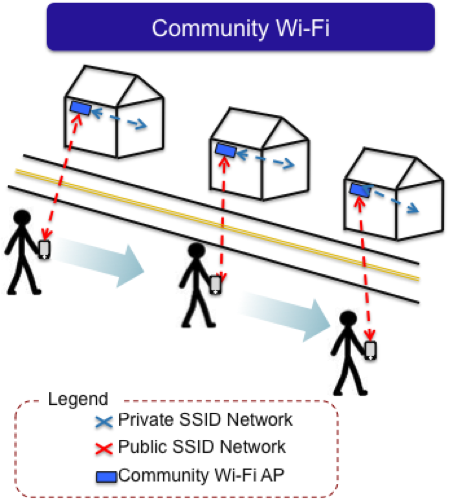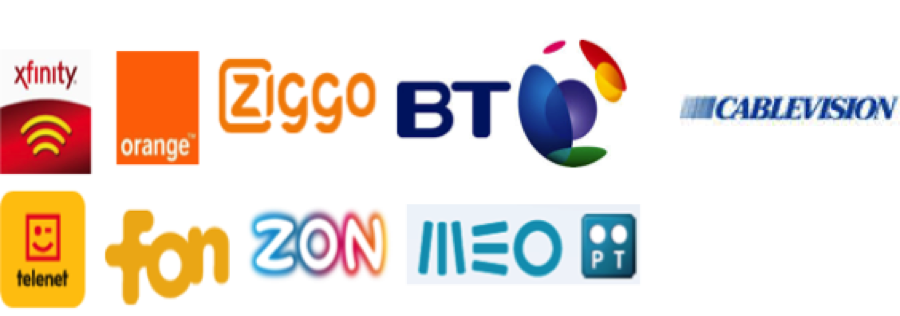Consumer
Community Wi-Fi – A Primer

When walking through a typical residential neighborhood today, all Wi-Fi access points in range are almost always locked, preventing access to anyone but the owner. Although subscribers pay for a certain high-speed broadband connection, bandwidth caps are not reached most of the time. An opportunity exists to optimize bandwidth resources for the benefit of the greater community, especially since cellular data networks are overloaded due to an ever-increasing number of users and resource intensive applications such as Google Maps, Facebook, etc.
Now imagine walking through the same residential neighborhood and having ubiquitous Wi-Fi connectivity from your neighbors’ access points. Instead of all access points being locked to visitors and passers by, everybody is able to connect. Phones (or any other Wi-Fi client) connect seamlessly from the coverage area of one house to another while neighbors still maintain the security and privacy of their locked access points. This scenario depicts a Community Wi-Fi network, and actually, it’s more real than you might imagine.
What is Community Wi-Fi?
Community Wi-Fi networks allow service providers to leverage unused capacity on existing Wi-Fi infrastructure to offer Wi-Fi network access to visitors and passers by. An operator can also use this excess capacity to offer services to retail and roaming–partner operators’ subscribers. The residential subscribers accessing the network from inside their homes have prioritized access to the Wi-Fi resources. The residential Wi-Fi infrastructure is configured in a manner that allows for a secure and independent access channel to retain service quality, safety, and privacy for both residential and visitor customers. Roaming users are only allowed to use the Wi-Fi network capacity that is not currently used by the subscriber at home.
Basically, the wireless Access Point (AP) in the home will provide two networks: a private one for the home owner/subscriber, and a community network for on-the-go subscribers passing through the neighborhood. While the user is at home, all of their Wi-Fi devices (smartphone, tablet, etc.) should automatically connect to the private network. When the user travels outside the vicinity of their AP’s coverage area, and passes in range of another AP operated by the same service provider, their client devices will be able to connect to the public network.
How does this benefit me?
A subscriber’s access point is made available to other on-the-go subscribers, adding to the number of access points within a Community Wi-Fi network. In return, the subscriber is able to tap into other shared access points within the Community Wi-Fi network. This gives access to the high bandwidth and speeds offered by cable Wi-Fi networks when on-the-go instead of having to use more costly cellular data networks. The subscriber is part of a community of shared Wi-Fi networks.
What about privacy and security concerns?
Traffic on the Public (Community Wi-Fi) network routes differently from that on the Private (subscriber home) network. At no point does a user on the Public network have access to any other device on the Public or Private network. The user of the Private network similarly does not have access to the traffic or devices on the Public network. All traffic on the Public network is sent through a secure tunnel to the core network before it is routed to the Internet, ensuring that traffic is separated between the two networks.
How far in the future is Community Wi-Fi?
It is actually already happening. A number of operators are planning or actively deploying community Wi-Fi networks. By year-end, Comcast Cable’s Xfinity WiFi network is expected to reach eight million hotspots. Community Wi-Fi deployments in the US alone are expected to reach a million APs this year. Many European operators already have large active community Wi-Fi deployments and are planning to expand.
Great! Where can I get more information?
CableLabs is working with our member companies and vendors to help solve challenges associated with the implementation of Community Wi-Fi. We are also working with Wireless Broadband Alliance (WBA) on publishing a white paper on Community Wi-Fi to be released in fall, 2014.
By Vivek Ganti -



